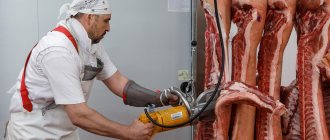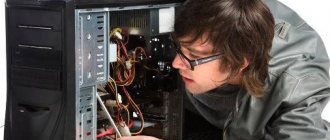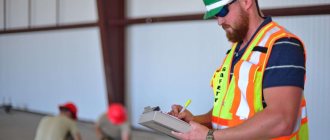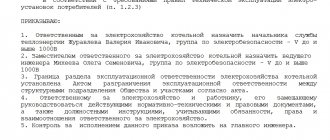I. General provisions
1. A person with a higher education – master’s degree or specialty (“Veterinary Medicine”) is appointed to the position of veterinarian.
2. No work experience requirements.
3. Appointment to the position of a veterinarian, as well as dismissal from it, is made by order of the head of the organization.
4. The veterinarian must know:
4.1. Methodology for collecting anamnesis of life and illness of animals
4.2. Factors in animal life that contribute to the occurrence of infectious and non-infectious diseases
4.3. Methods for restraining animals during their clinical examination
4.4. Techniques for conducting clinical research of animals using general methods in accordance with guidelines, instructions, rules for diagnosis, prevention and treatment of animals
4.5. Indications for the use of special (instrumental) and laboratory methods for studying animals in accordance with guidelines, instructions, rules for diagnosis, prevention and treatment of animals
4.6. Techniques for conducting animal research using special (instrumental) methods in accordance with guidelines, instructions, rules for diagnosis, prevention and treatment of animals
4.7. Methods and techniques for introducing diagnostic and radiopaque substances into the animal’s body
4.8. Rules for safe work with tools and equipment used when conducting special (instrumental) studies of animals, including when conducting x-ray studies
4.9. Methods of interpretation and analysis of data from special (instrumental) methods of animal research
4.10. Techniques for performing functional tests in animals
4.11. Methods for collecting and pre-processing samples of biological material to perform laboratory analyzes in accordance with instructions and methodological documents regulating the sampling of biological material
4.12. Standards for indicators of the state of biological material of animals of different species and the reasons causing deviations of indicators from the norms
4.13. Etiology and pathogenesis of animal diseases of various species
4.14. Generally accepted criteria and classifications of animal diseases, lists of animal diseases approved in accordance with the procedure established by the legislation of the Russian Federation
4.15. Forms and rules for filling out a journal for registering sick animals and animal medical history in accordance with veterinary reporting requirements
4.16. Veterinary and sanitary requirements for the process of autopsy of animals in accordance with the legislation of the Russian Federation in the field of veterinary medicine
4.17. Rules for working with special tools when dissecting animal corpses
4.18. Methods and techniques for autopsy of animal corpses of various species
4.19. Methods for collecting and preserving samples of pathological material for laboratory research in accordance with the rules in this field
4.20. Form and procedure for drawing up an animal autopsy report
4.21. Labor protection requirements in agriculture
4.22. Methods of drug treatment of sick animals and indications for their use in accordance with guidelines, instructions, manuals, rules for diagnosis, prevention and treatment of animals
4.23. State Register of Medicines for Veterinary Use
4.24. Pharmacological and toxicological characteristics of medicinal raw materials, drugs of chemical and biological nature, biologically active additives for the prevention and treatment of animal diseases of various etiologies
4.25. Types of non-drug therapy, including physiotherapy, used in veterinary medicine, and indications for their use
4.26. Surgical methods of treating animals and indications for their use
4.27 Types of dietary regimens, principles of feed selection, norms and feeding regimens for animal nutrition therapy
4.28. Techniques for introducing medicinal substances into the animal’s body by enteral (oral, sublingual and rectal administration) and parenteral (injection, inhalation and cutaneous applications) methods
4.29. Methods and techniques of non-drug effects on the animal’s body
4.30. Drugs used to anesthetize animals in veterinary surgery, doses and methods of their use, side effects
4.31. Rules for the use of special equipment in the operating room, surgical instruments and dressings
4.32. Surgical techniques in veterinary medicine
4.33. Types and techniques of suturing and dressings used in veterinary surgery
4.34. Recommended forms of a plan of anti-epizootic measures, a plan for the prevention of non-communicable animal diseases, a plan of veterinary and sanitary measures
4.35. The procedure for conducting a clinical examination of animals when planning preventive measures
4.36. The procedure for internal control of the veterinary and sanitary condition of the facility and the microclimate of livestock premises
4.37. Standard indicators of microclimate parameters in livestock buildings
4.38. Types of anti-epizootic measures and requirements for their implementation in accordance with guidelines, instructions, manuals, rules for diagnosis, prevention and treatment of animals
4.39. Types of measures for the prevention of non-communicable diseases and metabolic disorders in animals and requirements for their implementation in accordance with guidelines, instructions, manuals, rules for diagnosis, prevention and treatment of animals
4.40. Types of measures to ensure veterinary and sanitary safety and requirements for their implementation in accordance with the legislation of the Russian Federation in the field of veterinary medicine
4.41. Methods for conducting clinical examination of animals in accordance with the guidelines in force in this area
4.42. _____________________________________________________________________
5. The veterinarian reports directly to __________________.
6. During the absence of a veterinarian (vacation, illness, etc.), his duties are performed by a person appointed in the prescribed manner. This person acquires the corresponding rights and is responsible for their proper execution.
7. ________________________________________________________________
General provisions of the instructions
This section of the document displays the basic requirements for specialists accepted for this post and reveals the boundaries of the specialist’s knowledge. This section of the instructions also indicates what serves as a support for the veterinarian to perform actions within the framework of his activities.
The job description of a veterinarian states that a veterinarian belongs to the category of specialists. He is hired and dismissed by the head of the enterprise or his representative represented by the head of a structural unit or other official.
A person who has completed training as a veterinarian at a higher educational institution is accepted to the post of veterinarian. They are not required to work in their specialty.
A veterinarian of the 2nd category can become a person who studied to become a veterinarian at a university and has the education necessary for employment. To apply for this position, a minimum of three years of experience as a veterinarian is required.
A veterinarian of the 1st category is a specialist who studied to become a veterinarian and has a higher education. A prerequisite for admission to this position is at least 3 years of experience as a veterinarian of the 2nd category.
The main elements that guide the veterinarian in his work are:
- Regulatory legal acts, guidelines and methodological materials that are relevant to the work performed by a veterinarian.
- The charter of the organization, as well as orders and instructions of the immediate supervisor or head of the organization.
- Job description of a veterinarian.
If the veterinarian is temporarily absent, then his duties are performed by a person appointed responsible by the management of the organization. Such a person may be a veterinary assistant or another specialist specified by management in the relevant order.
II. Job responsibilities
The responsibilities of a veterinarian include:
1. Conducting a clinical examination of animals in order to establish a diagnosis:
— Collecting anamnesis of the life and illness of animals to identify the causes of diseases and their nature
— Conducting a general clinical examination of animals in order to establish a preliminary diagnosis and determine a further research program
— Development of an animal research program using special (instrumental) and laboratory methods
— Conducting a clinical study of animals using special (instrumental) methods to clarify the diagnosis
— Conducting a clinical study of animals using laboratory methods to clarify the diagnosis
— Diagnosis based on analysis of anamnesis data, general, special (instrumental) and laboratory research methods
— Carrying out post-mortem diagnostic examination of animals in order to establish pathological processes, diseases, causes of death
2. Carrying out measures to treat sick animals:
— Development of a treatment plan for animals based on the established diagnosis and individual characteristics of the animals
— Selection of necessary drugs of a chemical and biological nature for the treatment of animals, taking into account their cumulative pharmacological effect on the body
— Selection of non-drug therapy methods, including physiotherapeutic methods for treating animals
— Carrying out therapeutic procedures, including physiotherapeutic procedures, using special equipment in compliance with safety rules
— Determining the need to use surgical methods in the treatment of animals
— Development of a surgical plan, including the choice of anesthesia method
— Carrying out surgical intervention in the body of animals in the treatment of various diseases, castration, sterilization, for cosmetic purposes
— Development of recommendations for special feeding of sick animals for therapeutic purposes
— Carrying out repeated examinations and studies of animals to assess the effectiveness and safety of the prescribed treatment
— Adjustment of the treatment plan for animals (if necessary) based on the results of assessing the effectiveness of treatment
3. Organization of measures to prevent the occurrence of non-contagious, infectious and parasitic animal diseases to ensure sustainable animal health:
— Development of an annual plan of anti-epizootic measures, a plan for the prevention of non-communicable animal diseases, a plan of veterinary and sanitary measures
— Conducting clinical studies of animals in accordance with the plan of anti-epizootic measures, the plan for the prevention of non-communicable animal diseases
— Inspecting the veterinary and sanitary condition and microclimate of livestock premises in accordance with the plan of anti-epizootic measures, the plan for the prevention of non-communicable animal diseases, the plan of veterinary and sanitary measures
— Organization of measures to protect the organization from the introduction of infectious and invasive diseases in accordance with the plan of anti-epizootic measures
— Organization of preventive immunizations (vaccinations), therapeutic and prophylactic treatments of animals in accordance with the plan of anti-epizootic measures
— Organization of organizational, technical, zootechnical and veterinary activities aimed at the prevention of non-communicable diseases in accordance with the plan for the prevention of non-communicable animal diseases
— Organization of disinfection and disinsection of livestock premises to ensure veterinary and sanitary well-being in accordance with the plan of veterinary and sanitary measures
— Drawing up a plan for the medical examination of animals, taking into account their species and purpose
— Carrying out medical examinations in order to preserve the health of animals and increase their productivity
— Development of recommendations for carrying out therapeutic, preventive and therapeutic measures based on the results of examination of animals carried out as part of medical examination
— Promotion of veterinary knowledge, including in the field of prevention of animal diseases, among the organization’s employees
— Analysis of the effectiveness of measures to prevent animal diseases in order to improve them
Responsibilities of the position
The primary responsibilities performed by a veterinarian include carrying out preventive measures aimed at preventing diseases in animals and their mortality, as well as monitoring the implementation of veterinary and zoohygienic rules for keeping animals provided for by the organization’s charter. He also performs animal treatment and disinfection, disinsection and deratization procedures on the territory of the organization and premises intended for storing raw materials and products.
The responsibilities of this specialist also include:
- Inspection of animals before slaughter.
- Carrying out veterinary and sanitary examinations of products received after slaughter.
- Carrying out pathological autopsies of animal corpses.
- Carrying out veterinary branding of carcasses and skins of killed animals.
In addition, the veterinarian is obliged to check meat and meat products with the formation of appropriate conclusions on the suitability of the products, as well as monitor the sanitary condition of the products produced by the organization. His responsibilities include monitoring the storage conditions of raw materials, meat and meat products in warehouses.
The job description also provides for such responsibilities as drawing up reports on low-quality products, keeping records and preparing reporting veterinary documents established by the governing and regulatory documents of the organization. The list of responsibilities of a veterinarian concludes with monitoring compliance with the rules and regulations of fire safety and labor protection by employees directly subordinate to him, for example, an assistant veterinarian.
III. Rights
The veterinarian has the right:
1. Request and receive the necessary information, as well as materials and documents related to issues of their activities.
2. Improve your qualifications, undergo retraining (retraining)
3. Take part in the discussion of issues included in his functional responsibilities.
4. Make suggestions and comments on how to improve activities in the assigned area of work.
5. Require the management of the organization to provide assistance, including ensuring organizational and technical conditions and execution of the established documents necessary for the performance of official duties.
6. Make independent decisions, guided by qualification requirements and job responsibilities
7.___________________________________________________________
Official relationships
This section of the job description covers how the veterinarian may interact with the organization's employees. According to this document, the veterinarian reports only to the head of the structural unit or other official performing the duties of a manager.
Interaction with other employees of all structural divisions of the organization should not go beyond the competence of the veterinarian. According to the job description, this interaction consists of obtaining and providing documentation or information that is directly related to the work performed by the veterinarian.
IV. Responsibility
The veterinarian is responsible for:
1. For improper performance or failure to fulfill one’s job duties provided for in this job description - within the limits determined by the current labor legislation of the Russian Federation.
2. For offenses committed in the course of carrying out their activities - within the limits determined by the current administrative, criminal and civil legislation of the Russian Federation.
3. For causing material damage - within the limits determined by the current labor and civil legislation of the Russian Federation.
4. ____________________________________________________________________
This job description has been developed in accordance with the provisions (requirements) of the Labor Code of the Russian Federation dated December 30, 2001 No. 197 FZ (Labor Code of the Russian Federation) (with amendments and additions), the professional standard “Veterinarian” approved by order of the Ministry of Labor and Social Protection of the Russian Federation dated August 23, 2020 No. 547n and other legal acts regulating labor relations.
Job description for a veterinarian
Name of the organization APPROVED JOB Title of the position INSTRUCTIONS of the head of the organization _________ N ___________ Signature Explanation of the signature Place of compilation Date TO THE VETERINARY DOCTOR
GENERAL PROVISIONS
1. A veterinarian belongs to the category of specialists, is hired and dismissed from work by order of the head of the organization on the recommendation of ________________________________________________________________.
2. A person with a higher education in the specialty “Veterinary Medicine” is appointed to the position of veterinarian without presenting requirements for work experience.
3. In his activities, a veterinarian is guided by:
— regulatory documents on the work performed;
— methodological materials concerning relevant issues;
— the charter of the organization;
— labor regulations;
— orders and instructions from the head of the organization (direct manager);
- this job description.
4. The veterinarian must know:
— Law of the Republic of Belarus “On Veterinary Activities”, regulatory legal acts and other governing documents of higher authorities regulating veterinary activities of the quality and safety of food raw materials and food products;
— microbiology, epizootology;
— medicines and disinfectants, rules for their use;
— technology for the production of livestock products, requirements for their quality;
— zoohygienic and veterinary rules for keeping animals;
— the procedure for conducting veterinary and sanitary examinations;
— medicines and disinfectants, rules for their use;
— procedure for processing veterinary documents;
— the latest scientific achievements and best practices in the field of veterinary medicine and veterinary and sanitary examination;
— basics of using modern technical means, communications and communications, computer technology;
— fundamentals of labor legislation and environmental protection;
— rules and regulations of labor protection and fire safety.
5. During the absence of a veterinarian, his duties are performed in the prescribed manner by an appointed deputy, who bears full responsibility for the proper performance of the duties assigned to him.
JOB RESPONSIBILITIES
6. To perform the functions assigned to him, the veterinarian is obliged to:
6.1. Carry out planning, development and implementation, in accordance with the legislation, of a system of preventive, diagnostic and veterinary-sanitary measures in serviced organizations, settlements, peasant (farm) households, citizens, etc. in order to prevent diseases and mortality of animals.
6.2. Provide veterinary services for the prevention, diagnosis of animal diseases and their treatment.
6.3. Monitor compliance with veterinary, sanitary and zoohygienic rules when feeding, housing, and reproduction of animals, as well as rules for their care and use, aimed at improving the quality of products of animal origin intended for food and processing.
6.4. Ensure disinfection, disinfestation, deratization and decontamination on livestock farms, livestock farms, areas and premises for processing and storing products of animal origin.
6.5. Conduct pre-slaughter inspection of animals, organize veterinary branding of meat carcasses and skins, and post-mortem autopsies of animal corpses.
6.6. Report in the prescribed manner information about the detection of contagious diseases among serviced and slaughtered animals.
6.7. Compose applications and receive the necessary veterinary drugs.
6.8. Ensure rational use, storage, and accounting of receipts of veterinary drugs and other veterinary property.
6.9. Introduce new veterinary products, scientific achievements and best practices in the field of veterinary medicine.
6.10. Monitor the implementation in the organization of the Law of the Republic of Belarus “On Veterinary Activities”, veterinary and sanitary rules and rules for the protection of the population from diseases common to humans and animals.
6.11. Ensure record keeping and preparation of established veterinary reports.
6.12. Monitor compliance with veterinary and sanitary rules during herd reproduction.
6.13. Participate in the study of cows for pregnancy.
6.14. Carry out veterinary measures to prevent and eliminate the barrenness of breeding stock and raise healthy young animals.
6.15. Monitor and ensure compliance with environmental legislation, labor protection and fire safety regulations.
RIGHTS
7. A veterinarian has the right:
7.1. Get acquainted with draft decisions of the organization’s management relating to its activities.
7.2. Submit proposals for improvement of work related to the responsibilities provided for in these instructions for consideration by management.
7.3. Receive from heads of structural divisions, specialists information and documents necessary to perform their job duties.
7.4. Involve specialists from all structural divisions of the organization to resolve the responsibilities assigned to him (if this is provided for by the regulations on structural divisions, if not, with the permission of the head of the organization).
7.5. Require the management of the organization to provide assistance in the performance of their official duties and rights.
7.6. Take part in the discussion of labor safety issues submitted for consideration at meetings (conferences) of the labor collective (trade union organization).
RELATIONSHIPS (JOB RELATIONS)
8. The veterinarian reports to _____________________________________ __________________________________________________________________________. 9. The veterinarian interacts on issues within his competence with employees of the following structural divisions of the organization: - with _________________________________________________________________: receives: __________________________________________________________________________; is: __________________________________________________________________________; — from _________________________________________________________________: receives: ________________________________________________________________________________; is: __________________________________________________________________________.
PERFORMANCE EVALUATION AND RESPONSIBILITY
10. The work of the veterinarian is assessed by the immediate supervisor (other official).
11. The veterinarian is responsible for:
11.1. For failure to perform (improper performance) of one’s job duties as provided for in this job description - within the limits determined by the current labor legislation of the Republic of Belarus.
11.2. For offenses committed in the course of carrying out their activities - within the limits determined by the current administrative, criminal and civil legislation of the Republic of Belarus.
11.3. For causing material damage - within the limits determined by the current labor, criminal and civil legislation of the Republic of Belarus.
11.4. For failure to comply with the rules and regulations of labor protection, safety precautions, industrial sanitation and fire protection - in accordance with the requirements of regulatory legal acts of the Republic of Belarus and local acts in _____________________.
Name of the position of the head of the structural unit _________ _______________________ Signature Explanation of signature Visas I have read the instructions _________ _______________________ Signature Explanation of signature _______________________ Date
A COMMENT
The job description was developed in accordance with the Qualification Directory of positions for employees engaged in veterinary activities, approved by Resolution of the Ministry of Labor and Social Protection of the Republic of Belarus dated July 18, 2012 N 80.
These instructions are exemplary. It can be used as a basis for developing appropriate employee instructions, taking into account the specifics of the organization’s activities.
Complex of duties of a veterinarian
a) observation of the life and behavior of animals
b) identifying the causes of animal disease
c) diagnosing an animal disease and prescribing treatment
d) preventive measures to prevent diseases in animals and people
e) monitoring compliance with sanitary standards on farms and in animal habitats
f) conducting veterinary examination of food products of animal origin (meat, eggs, milk, butter, honey, etc.)
e) carrying out artificial insemination of animals and providing them with obstetric care.
Similar statistics on veterinary medicine
History of the development of anatomy in veterinary medicine: ancient times
Happy Veterinary Medicine Worker's Day!
Tetanus: epizootology and pathogenesis
Tags: veterinary medicine





